Match the event: Penetration.
- Maternal and paternal gametes join to become a zygote.
- Enzymes of sperm acrosomes digest the zona pellucida.
- The entry of the oocyte into the uterine tube
- The blastocyst is buried in the endometrium.
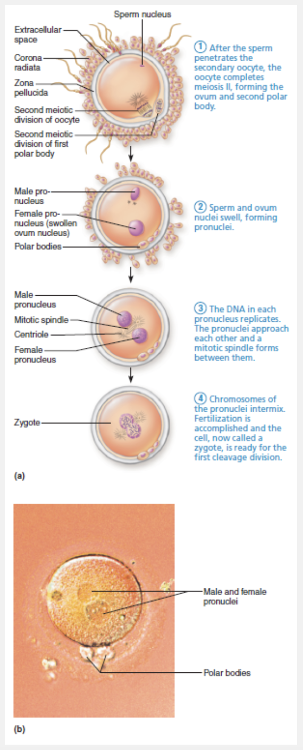
Enzymes of sperm acrosomes digest the zona pellucida.
Ex.
Penetration occurs when enzymes of sperm acrosomes digest the zona pellucida.
The ovulated oocyte is encapsulated by the corona radiata and by the deeper zona pellucida (ZP), a transparent layer of glycoprotein-rich extracellular matrix secreted by the oocyte. Both must be breached before the oocyte can be penetrated. Once in the immediate vicinity of the oocyte, a sperm weaves its way through the cells of the corona radiata. This journey is assisted by a cell-surface hyaluronidase on the sperm that digests the intercellular cement between the granulosa cells in the local area, causing them to fall away from the oocyte.
__________ refers to events that occur from the time of fertilization (conception) until the infant is born.
- Fetal period
- Embryonic period
- Gastrulation
- Pregnancy
Pregnancy
Ex.
Pregnancy refers to events that occur from the time of fertilization (conception) until the infant is born.
The term pregnancy refers to events that occur from the time of fertilization (conception) until the infant is born. The pregnant woman’s developing offspring is called the conceptus (kon-sep′tus; “that which is conceived”). Development occurs during the gestation period (gestare = to carry), which extends by convention from the last menstrual period (a date the woman is likely to remember) until birth, approximately 280 days. So, at the moment of fertilization, the mother is officially (but illogically) two weeks pregnant!
At week _______, the conceptus is now called an embryo.
- eight
- three
- fourteen
- twenty-one
- one
three
Ex.
The conceptus is known as the embryo up to the third week.
From fertilization through week 8, the embryonic period, the conceptus is called an embryo, and from week 9 through birth, the fetal period, the conceptus is called a fetus (“the young in the womb”). At birth, it is an infant (neonate). The figure below shows the changing size and shape of the conceptus as it progresses from fertilization to the early fetal stage.
All except which of the following prevent polyspermy?
- The release of Ca2+ after the sperm has entered the ova
- Natural elimination of an embryo with too much genetic material
- The spilling of enzymes into the extracellular space beneath the zona pellucida
- A decrease in zonal inhibiting proteins
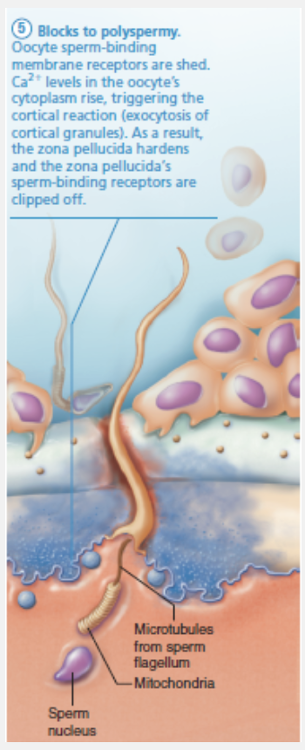
A decrease in zonal inhibiting proteins
Ex.
A decrease in zonal inhibiting proteins does not prevent polyspermy.
Polyspermy (entry of several sperm into an egg) occurs in some animals, but in humans only one sperm is allowed to penetrate the oocyte, ensuring monospermy, the one-sperm-per-oocyte condition. In the rare cases of polyspermy that do occur, the embryos contain too much genetic material and die. At least two mechanisms help ensure monospermy: the oocyte membrane block and the zona reaction.
The oocyte membrane block was poorly understood in humans until recently. We now know that when a sperm binds to the oocyte’s sperm-binding receptors, it causes the oocyte to shed the remaining sperm-binding receptors on the surface of vesicles that bud off the plasma membrane. In the absence of sperm receptors, additional sperm are unable to bind to the oocyte. The released vesicles, studded with sperm-binding receptors, may act as “decoys” that attract and bind any other sperm that make it through the zona pellucida.
The zona reaction (also called the slow block to polyspermy) alters the physical characteristics of the zona pellucida. Once the sperm head has entered the oocyte, waves of Ca2+ are released by the oocyte’s endoplasmic reticulum into its cytoplasm, which activates the oocyte to prepare for the second meiotic division. These calcium surges also cause the cortical reaction, in which granules located just inside the plasma membrane spill their enzymes into the extracellular space beneath the zona pellucida. These enzymes, called zonal inhibiting proteins (ZIPs), destroy the zona pellucida sperm-binding receptors. Additionally, the spilled material binds water, and as the material swells and hardens, it detaches all sperm still bound to zona pellucida receptors.
Sperm are known to bear __________ that respond to chemical stimuli that help them locate the ova.
- acrosomes
- multiple tails
- olfactory receptors
- hydrolytic enzymes
olfactory receptors
Ex.
Sperm are known to bear olfactory receptors that respond to chemical stimuli that help them locate the ova.
How do sperm navigate to find a released oocyte in the uterine tube? This question is an area of active research. It now appears that they “sniff” their way to the oocyte. Sperm bear proteins called olfactory receptors that respond to chemical stimuli. It is presumed that the oocyte or its surrounding cells release signaling molecules that direct the sperm.
An ovum is formed by _______.
- meiosis
- mitosis
- a sperm penetrating the egg and the oocyte completing meiosis II
- nondisjunction of chromosomes

a sperm penetrating the egg and the oocyte completing meiosis II
Ex.
An ovum is formed by a sperm penetrating the egg and the oocyte completing meiosis II.
After the sperm penetrates the secondary oocyte, the oocyte completes meiosis II, forming the ovum and second polar body.
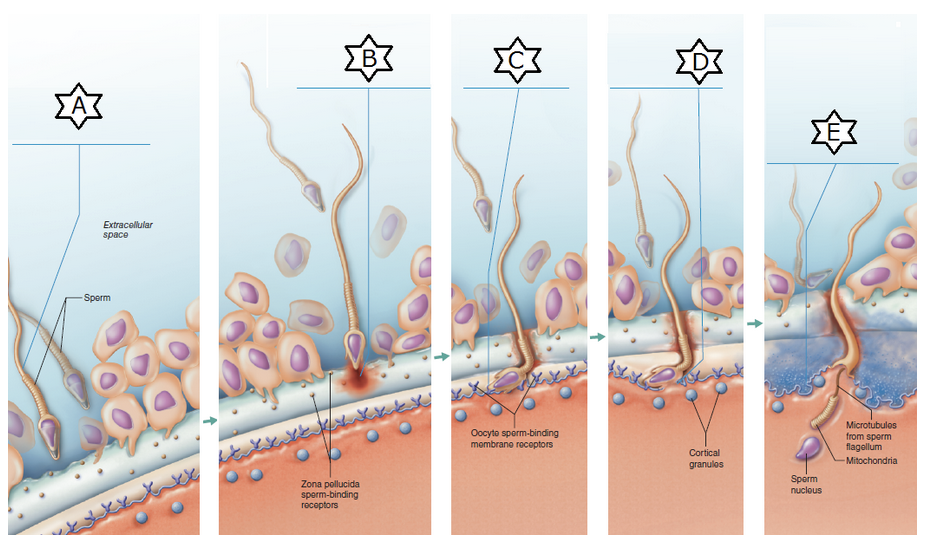
Identify the physiological process at “A.”
- Sperm bind to the oocyte’s sperm-binding receptors.
- Sperm contents enter the oocyte.
- The zona pellucida hardens and sperm-binding receptors are clipped off.
- A sperm cell weaves its way past granulosa cells of the corona radiata.
- Calcium levels within the sperm rise and trigger the acrosomal reaction.
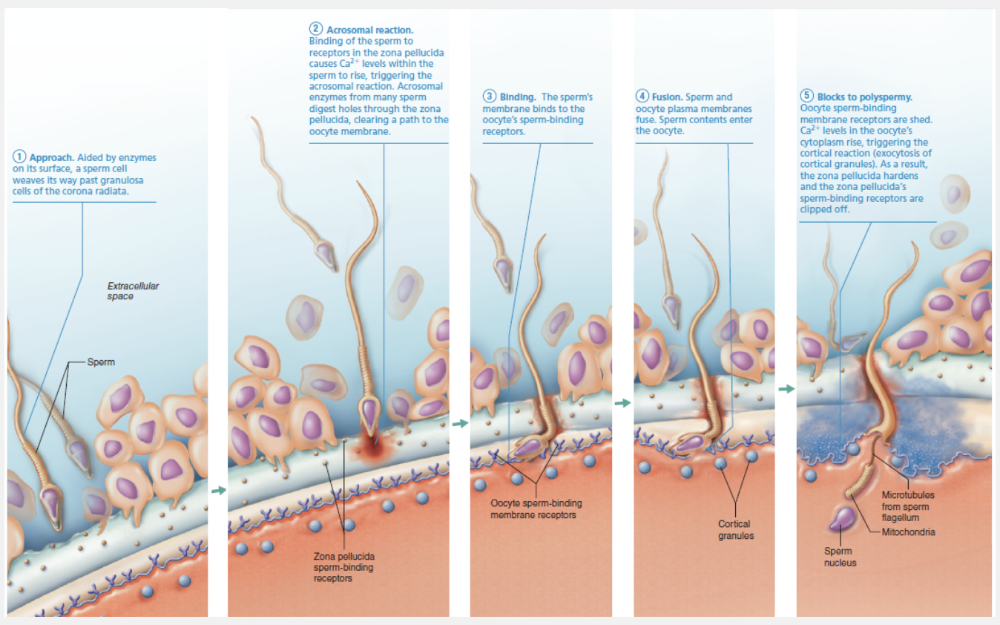
A sperm cell weaves its way past granulosa cells of the corona radiata.

Identify the physiological process at “B.”
- The zona pellucida hardens and sperm-binding receptors are clipped off.
- Calcium levels within the sperm rise and trigger the acrosomal reaction.
- A sperm cell weaves its way past granulosa cells of the corona radiata.
- Sperm contents enter the oocyte.
- Sperm bind to the oocyte’s sperm-binding receptors.

Calcium levels within the sperm rise and trigger the acrosomal reaction.

Identify the physiological process at “C.”
- Sperm bind to the oocyte’s sperm-binding receptors.
- Sperm contents enter the oocyte.
- Calcium levels within the sperm rise and trigger the acrosomal reaction.
- The zona pellucida hardens and sperm-binding receptors are clipped off.
- A sperm cell weaves its way past granulosa cells of the corona radiata.

Sperm bind to the oocyte’s sperm-binding receptors.

Identify the physiological process at “D.”
- Sperm bind to the oocyte’s sperm-binding receptors.
- A sperm cell weaves its way past granulosa cells of the corona radiata.
- Sperm contents enter the oocyte.
- The zona pellucida hardens and sperm-binding receptors are clipped off.
- Calcium levels within the sperm rise and trigger the acrosomal reaction.

Sperm contents enter the oocyte.

Identify the physiological process at “E.”
- Sperm contents enter the oocyte.
- A sperm cell weaves its way past granulosa cells of the corona radiata.
- The zona pellucida hardens and sperm-binding receptors are clipped off.
- Calcium levels within the sperm rise and trigger the acrosomal reaction.
- Sperm bind to the oocyte’s sperm-binding receptors.

The zona pellucida hardens and sperm-binding receptors are clipped off.
A zygote contains __________.
- 92 chromosomes
- the diploid number of chromosomes
- 23 chromosomes
- chromosome nondisjunctions

the diploid number of chromosomes
Ex.
A zygote contains a diploid number of chromosomes.
The true moment of fertilization occurs as the maternal and paternal chromosomes combine and produce the diploid zygote, or fertilized egg. Some sources define the term fertilization simply as the act of oocyte penetration by the sperm. However, unless the chromosomes in the male and female pronuclei are actually combined, the zygote is never formed in humans. The zygote, the first cell of a new individual, is now ready to undergo the first mitotic division of the conceptus.
Match the event: Fertilization.
- Maternal and paternal gametes join to become a zygote.
- Initial attachment of the blastocyst to the endometrium
- Enzymes of sperm acrosomes digest the zona pellucida.
- The blastocyst is buried in the endometrium.

Maternal and paternal gametes join to become a zygote.
Ex.
Fertilization occurs when maternal and paternal gametes join to become a zygote.
The true moment of fertilization occurs as the maternal and paternal chromosomes combine and produce the diploid zygote, or fertilized egg. Some sources define the term fertilization simply as the act of oocyte penetration by the sperm. However, unless the chromosomes in the male and female pronuclei are actually combined, the zygote is never formed in humans. The zygote, the first cell of a new individual, is now ready to undergo the first mitotic division of the conceptus.
Match the embryonic term with its correct characteristic: Fetus.
- A fluid-filled, hollow ball of cells
- Beginning at week nine
- Consists of three primary germ layers and embryonic membranes
- A single-celled embryo
- A berry-shaped cluster of 16 or more cells
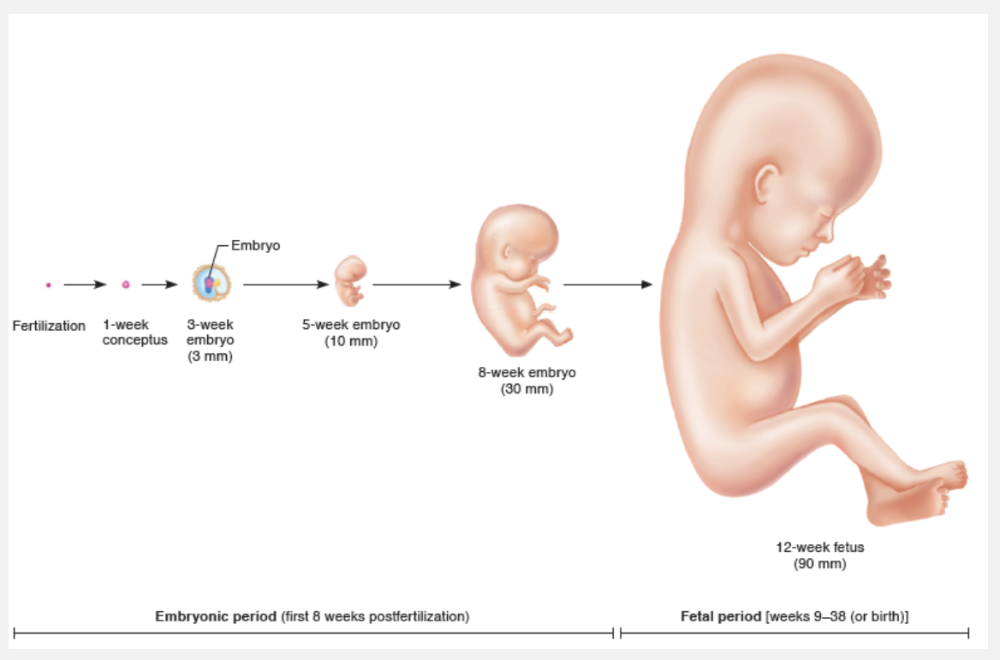
Beginning at week nine
Ex.
Beginning at week 9, the embryon becomes termed a fetus.
From fertilization through week 8, the embryonic period, the conceptus is called an embryo, and from week 9 through birth, the fetal period, the conceptus is called a fetus (“the young in the womb”). At birth, it is an infant. Figure 28.1 shows the changing size and shape of the conceptus as it progresses from fertilization to the early fetal stage.